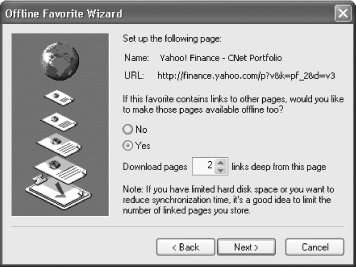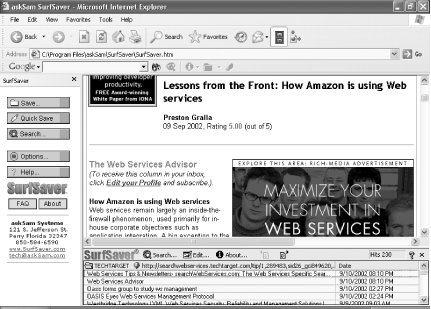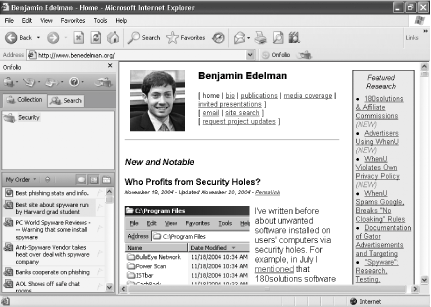Hack38.Read Web Pages Offline
|
Hack 38. Read Web Pages Offline
Take the Web with you wherever you go, and put it into an easily searchable database on your PC. One of the main problems with doing research on the Web is that there's no easy way to save all the information you find and no simple way to read web pages when you're offline. Internet Explorer includes some basic tools for saving web pages and reading through them when you're not connected to the Internet. If you need to save only occasional pages and don't need to do searches through those pages, these tools will work reasonably well for you. But if you want to store pages in categories and folders and need to do full-text searches, you'll need a third-party program. This hack shows you how to do both. 4.8.1. Reading Web Pages Offline Using IETo save your current web page to your hard disk so that you can read it again in Internet Explorer when you're not connected to the Internet, choose File There are times when you want to save not just the page you're on, but also the pages linked off it. To do that, you'll have to save your pages another way. First, save the page to your Favorites list by pressing Ctrl-D or choosing Favorites Figure 4-20. Saving web pages offline several links deep using the Offline Favorite Wizard When you finish the wizard, you're asked how you want to synchronize the page or pages you've chosen to save to disk. When you synchronize a web page, IE grabs the latest version of the page or pages and overwrites your existing page or pages. If you want to keep a permanent copy of the page or pages, and you don't want them updated, choose "Only when I choose Synchronize from the Tools menu." Then, simply don't synchronize the page. If you do want to synchronize the page so that a more current version is available on your hard disk, choose "I would like to create a new schedule," and follow the instructions for creating a schedule. 4.8.2. Save Web Pages in an Offline Database with Add-InsIf you need to save many web pages and want to be able to search through them by full-text or keyword searches, you'll have to use a third-party program. A very good one is SurfSaver, available from http://www.surfsaver.com (see Figure 4-21). It integrates directly into Internet Explorer and lets you save pages in separate folders within the program. You can add keywords and notes to each page, and then search by keyword or full text, or browse by folder. Figure 4-21. Saving web pages in a database with SurfSaver When you visit a web page you want to save locally, right-click the page, choose SurfSaver Save, and choose which SurfSaver folder you want to save it in. You can save the page with or without graphics. When you want to search, right-click the page, choose SurfSaver Search, and then search by keyword, through notes, or through the full text on the page to easily find the page and information you want. SurfSaver also integrates directly with the freeform askSam database. It's shareware; you can try it out for free, but if you continue to use it, it costs $19.95. My current favorite of these programs is Onfolio, shown in Figure 4-22. Like SurfSaver, it integrates with Internet Explorer, although it also integrates with Firefox, and it can work independently of a browser as well. It's more visually pleasing than SurfSaver, makes it easier to organize your pages in folders and subfolders, and it includes excellent search tools. When you want to save a web page locally, press F9, or drag the address bar to Onfolio. Figure 4-22. Onfolio, which makes it easy to browse to pages you've saved offline Onfolio is shareware, and is free to try, but it costs $49.95 if you decide to keep it. Get it from http://www.onfolio.com. |
|
EAN: 2147483647
Pages: 191
 Save As. Youll be given several options for how to save it. If you're not planning to edit the HTML of the file, your best bet is to save it as a "Web Archive, single file" (.mht). That way, you don't clutter up your hard disk with extra folders and files stored in different locations; everything is saved to a single file. Saving it as a "Web Page, complete" stores the HTML file as well as associated graphics, in a folder structure. Saving it as a "Web Page, HTML only" saves just the HTML file itself, with no associated graphics and no folder structure. You can also save it as a text file, but if you do, expect to spend time cleaning it up because it saves all the text on the page, often in an unstructured way. To read the page after you've saved it to your disk, choose File
Save As. Youll be given several options for how to save it. If you're not planning to edit the HTML of the file, your best bet is to save it as a "Web Archive, single file" (.mht). That way, you don't clutter up your hard disk with extra folders and files stored in different locations; everything is saved to a single file. Saving it as a "Web Page, complete" stores the HTML file as well as associated graphics, in a folder structure. Saving it as a "Web Page, HTML only" saves just the HTML file itself, with no associated graphics and no folder structure. You can also save it as a text file, but if you do, expect to spend time cleaning it up because it saves all the text on the page, often in an unstructured way. To read the page after you've saved it to your disk, choose File  Open, browse to the directory where you've saved the page, and open it.
Open, browse to the directory where you've saved the page, and open it.